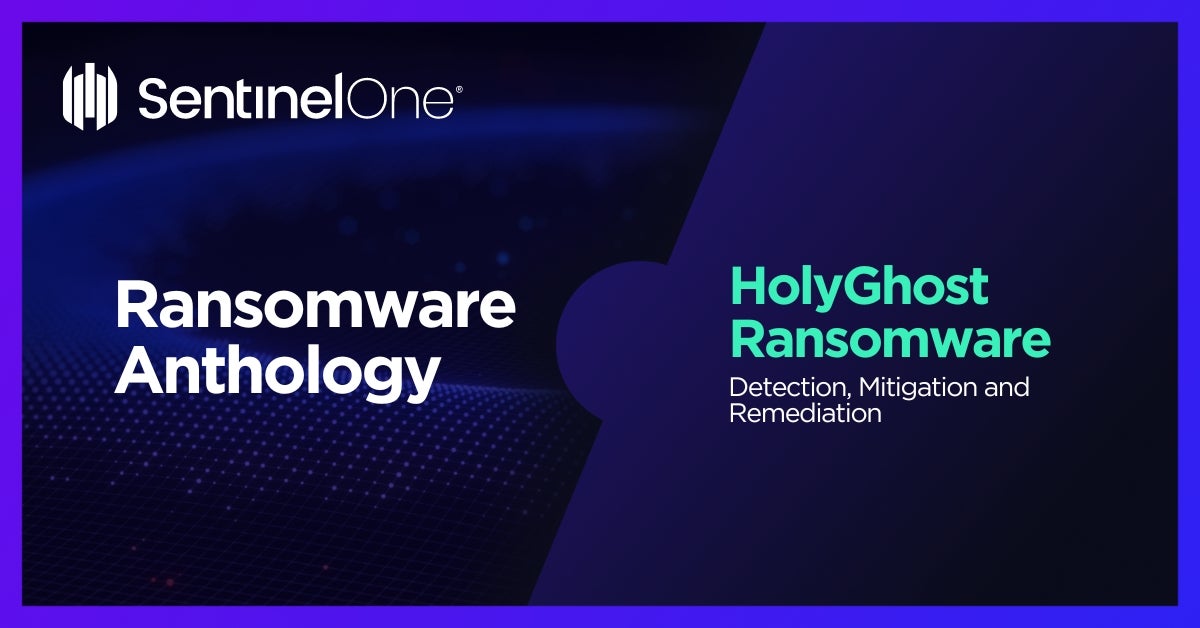HolyGhost (H0lyGh0st) Ransomware: In-Depth Analysis, Detection, and Mitigation
Summary of HolyGhost Ransomware
HolyGhost ransomware (aka H0lygh0st) emerged in June 2021 and is operated by North Korean threat actors DarkSeoul (aka DEV-0530). HolyGhost targets corporate networks and engages in multi- extortion – demanding payment for decryption tools, as well as for the non-release of stolen data. While HolyGhost resembles traditional ransomware, it is also observed in conjunction with broader and more advanced threats out of the DPRK.

What Does HolyGhost Ransomware Target?
HolyGhost ransomware primarily targets SMBs (small-to-midsize businesses) within the education, financial, manufacturing and entertainment industries.
How Does HolyGhost Ransomware Spread?
HolyGhost ransomware can be deployed in multiple ways, such as with Cobalt Strike or a similar framework, as well as through phishing. Additionally,targeting of CVE-2022-26352 (remote code execution in DotCMS) has been observed.
HolyGhost Ransomware Technical Details
HolyGhost payloads are based around the SiennaPurple and SiennaBlue variations of the malware, observed in 2021. Subsequent HolyGhost payloads are written in Go and contain a number of functions to improve efficiency and stealthiness. These include internal string obfuscation, public key management, log and binary self-deletion, and evasion of Microsoft Windows Defender.
Initial delivery occurs via spear phishing or exploitation of known vulnerabilities (example: CVE-2022-26352). Upon infection, the attackers first attempt to exfiltrate all desired data, prior to deploying and launching the ransomware payloads. In addition to having ransom notes dropped on their device(s), HolyGhost victims have also reported receiving emails and calls from attackers, alerting them to what their next steps should be. Persistence is achieved via scheduled tasks.
The HolyGhost ransomware operation has been linked to actors in North Korea. Direct ties to the DPRK government are suspected but uncorroborated.
How to Detect HolyGhost Ransomware
- The SentinelOne Singularity XDR Platform can identify and stop any malicious activities and items related to HolyGhost ransomware.
In case you do not have SentinelOne deployed, detecting ransomware requires a combination of technical and operational measures designed to identify and flag suspicious activity on the network. This allows the organization to take appropriate action, and to prevent or mitigate the impact of the ransomware attack.
To mitigate the risk of this Ransomware without SentinelOne deployed, it is important to take a multi-layered approach, which includes the following steps:
- Use anti-malware software or other security tools capable of detecting and blocking known ransomware variants. These tools may use signatures, heuristics, or machine learning algorithms, to identify and block suspicious files or activities.
- Monitor network traffic and look for indicators of compromise, such as unusual network traffic patterns or communication with known command-and-control servers.
- Conduct regular security audits and assessments to identify network and system vulnerabilities and ensure that all security controls are in place and functioning properly.
- Educate and train employees on cybersecurity best practices, including identifying and reporting suspicious emails or other threats.
- Implement a robust backup and recovery plan to ensure that the organization has a copy of its data and can restore it in case of an attack.
How to Mitigate HolyGhost Ransomware
- The SentinelOne Singularity XDR Platform can return systems to their original state (which is free from re-infection) using either the Repair or Rollback feature.
In case you do not have SentinelOne deployed, there are several steps that organizations can take to mitigate the risk of ransomware attacks:
- Educate employees: Employees should be educated on the risks of ransomware, and on how to identify and avoid phishing emails, malicious attachments, and other threats. They should be encouraged to report suspicious emails or attachments, and to avoid opening them, or clicking on links or buttons in them.
- Implement strong passwords: Organizations should implement strong, unique passwords for all user accounts, and should regularly update and rotate these passwords. Passwords should be at least 8 characters long, and should include a combination of uppercase and lowercase letters, numbers, and special characters.
- Enable multi-factor authentication: Organizations should enable multi-factor authentication (MFA) for all user accounts, to provide an additional layer of security. This can be done through the use of mobile apps, such as Google Authenticator or Microsoft Authenticator, or through the use of physical tokens or smart cards.
- Update and patch systems: Organizations should regularly update and patch their systems, to fix any known vulnerabilities, and to prevent attackers from exploiting them. This includes updating the operating system, applications, and firmware on all devices, as well as disabling any unnecessary or unused services or protocols.
Implement backup and disaster recovery: Organizations should implement regular backup and disaster recovery (BDR) processes, to ensure that they can recover from ransomware attacks, or other disasters. This includes creating regular backups of all data and systems, and storing these backups in a secure, offsite location. The backups should be tested regularly, to ensure that they are working, and that they can be restored quickly and easily.